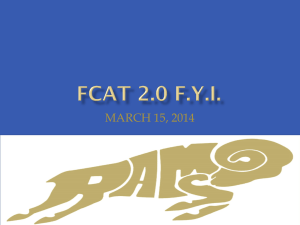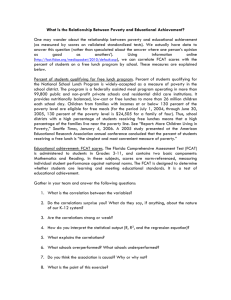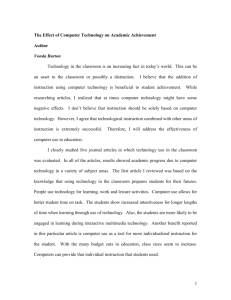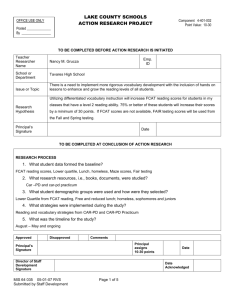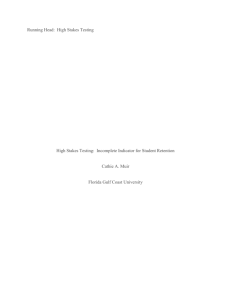Independent Daily Classroom Reading and its Effects on
advertisement
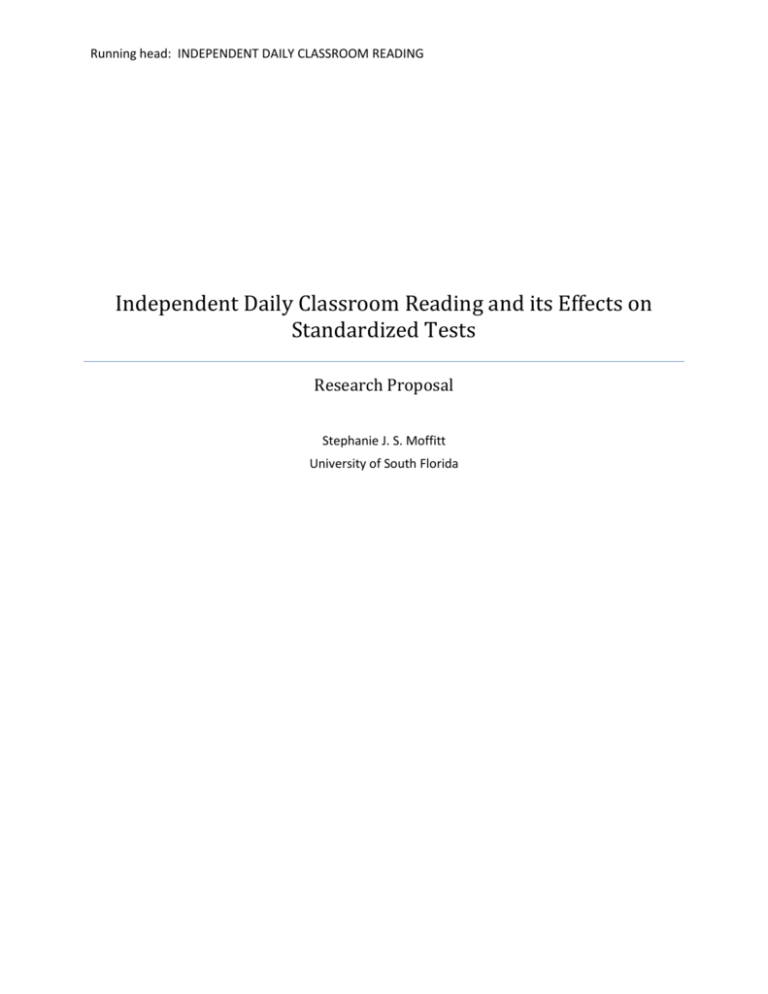
Running head: INDEPENDENT DAILY CLASSROOM READING Independent Daily Classroom Reading and its Effects on Standardized Tests Research Proposal Stephanie J. S. Moffitt University of South Florida INDEPENDENT DAILY CLASSROOM READING 2 Abstract This study will attempt to show that there is no correlation between a program of daily independent reading in the classroom and increased standardized test scores. The design of the study is quasi-experimental time-series, using a pre-test, post-test, and three observation points, which will be graphed to determine whether or not there is a significant increase in developmental scale score points on the Florida Comprehensive Assessment Test after a full year of program implementation. INDEPENDENT DAILY CLASSROOM READING 3 Independent Daily Classroom Reading and its Effects on Standardized Tests The Florida Comprehensive Assessment Test (FCAT) is administered once per year, usually in March. All students in grades three through ten take the reading portion of the FCAT. Schools use FCAT data to determine whether a student will need to be placed into an intensive reading class. Students who score below a Level 3 (basic mastery) must be placed in a reading class the following school year. This study employs a single-group quasi-experimental design to show that no relationship exists between independent daily engaged reading and increased standardized test scores. It uses FCAT data and data from Florida Assessments for Instruction in Reading (FAIR) as pre-test (8th grade FCAT), three observation points (FAIR) and post-test (9th grade FCAT). Literature Review The problem addressed in this proposal is the question of whether or not independent daily classroom reading will increase students’ reading ability, and subsequently their reading test scores. The program of independent reading this study will implement is one that has been touted as an important factor in increased standardized reading test scores and is sometimes called silent sustained reading, but more recently has been called by many other names. It is, basically, independent reading practice which takes place in the classroom. The National Reading Panel (2000) determined that silent sustained reading was not effective in increasing students’ ability to comprehend texts, and that there was little or no effect on standardized test scores when this teaching practice took place in classrooms. Despite that evidence, ongoing research has continued for the past ten years, yet only concedes that while it is true that silent sustained reading is not effective, it is not effective because it was implemented incorrectly in the INDEPENDENT DAILY CLASSROOM READING 4 classroom. The Florida Department of Education (FLDOE) states in a JustReadFlorida (2008) report that independent reading activities account for twenty percent of students’ reading ability. That same report recommends that independent reading practice involve students’ reading texts at their reading level, which can be as low as three or more levels below their grade level assignment. John Guthrie of the University of Maryland has done a considerable amount of research on student motivation and engaged reading, and is a proponent of the theory: In this perspective, highly engaged readers are both internally motivated and strategic, and less engaged readers show lower motivation and less use of strategies for comprehending text. Consistent with this perspective, Fredricks, Blumenfeld, and Paris (2004) proposed that engagement is a multidimensional attribute including behavioral engagement (actively performing academic learning tasks), cognitive engagement (using high-level strategies to foster deep learning), and emotional engagement (enjoying academic tasks and expressing enthusiasm about learning) (Wigfield & Guthrie, 2008). Guthrie has amassed a large body of work, seemingly in response to the National Reading Panel study. He and others still consider it an important component of reading achievement and it is recommended also by JustReadFlorida (2008), albeit with qualifications, and is therefore a continued practice. Methodology The design of the study is quasi-experimental as there is no random assignment of subjects to the group (Powell & Connaway, 2004). All incoming ninth graders who scored a Level 2 on the eighth grade FCAT will be placed into the study group. These will consist of INDEPENDENT DAILY CLASSROOM READING 5 approximately 100 students in five reading classes, and these students are generally assumed to be reading three or more levels below their assigned grade, per FCAT score and level. This study will use a time-series design, and the data will be compiled by the classroom teacher. The students’ data will be graphed over the twelve months between state assessments, including developmental scale score, FCAT success probability on FAIR tests (computed by the testing software), and scores on the four individual categories of the FCAT. The data will be broken down into the four tested components of the FCAT: main idea, plot, and purpose; words and phrases in context; reference and research; and comparisons and cause/effect. Using inferential statistics, the difference between the developmental scale scores (DSS) from the two administered FCATs will be used to determine “learning gains,” currently defined by an increase in the DSS of 78 points. If the mean of the difference does not show learning gains (is not at least 78 points), no correlation will be assumed (Powell & Connaway, 2004). The classroom teacher will obtain FCAT data from the state reports which are sent to each school district, which are reported by teacher, classroom, and student, and further reported by tested component. FAIR data will be obtained through Florida’s Progress Monitoring & Reporting Network (PMRN), a tool which disaggregates the data much the same way, but includes an FCAT success probability with each assessment. Budget There are two ways to view a budget for this study. On one hand, it could be said that the study will cost nothing, as these tests will be administered and these students will be placed into these classes even if no study takes place, or even if a program of independent daily reading is not implemented. The costs associated with the study will exist with or without it. The reading material the students will be using already exists, or can be accessed via the Internet. On the INDEPENDENT DAILY CLASSROOM READING 6 other hand, one could factor in the cost per student of administering, scoring and reporting the FCAT data and then dividing per student expenditures by seven (there are seven courses in the school day, this study will take place in the reading course). It would also be necessary to divide the cost of employing a reading coach by the number of students in the study, and further dividing by the number of hours the reading coach spends administering the FAIR test to these students, and then adding all these factors to determine a final cost. Limitations The limitations of this design are such that it cannot rule out other factors such as motivation to succeed as the FCAT is a high-stakes test, and has unpleasant consequences for those who do not pass. For example, a student might spend independent reading time sleeping every day, and still be able to increase his standardized test score sufficiently in order to avoid being placed in a reading class the following year. There are a number of variables that cannot be controlled, including parental involvement, other coursework (which may increase knowledge), and other components of the reading instruction program. Maturation is also a consideration, especially with the age group studied; students who are entering high school have increased expectations in all coursework, increased expectations for responsible academic behavior, and most tend to be maturing physically at this age at a rapid rate as well. Since the study must take place over an entire year, there may be a significant difference in student attitudes toward the test itself and/or a general level of increased academic knowledge and responsibility by the end of the study. External validity is weak in a time-series design, and the main threat to external validity in this design is not the expected one: that these subjects might be more receptive to the program INDEPENDENT DAILY CLASSROOM READING 7 than the general population, but in fact, because they are struggling readers, they might be much less receptive to the experimental variable (Powell & Connaway, 2004). Expected Results It is expected that there will be no correlation between independent daily reading and increased standardized test scores. The studies that have preceded this one have used multiple independent variables, and therefore cannot speak to the success of one program’s affect on increased reading ability. The practice of independent daily reading might work if the student choice of materials were removed from the method, the materials were leveled to challenge the student, and do so rapidly. Further research in this area is necessary, for it only seems logical that students who consistently spend their reading time consuming materials that are below their expected level of mastery cannot increase their reading ability, they will only remain at that level; they must be exposed continuously to material which challenges them, increases their general world knowledge, and causes growth in reading comprehension. Mere practice at the same level of inefficiency will not foster growth. This study will attempt to validate the study done by the National Reading Panel ten years ago; there is no correlation between independent reading practice and increased reading ability, especially for students who are reading three or more levels below their assigned grade. INDEPENDENT DAILY CLASSROOM READING 8 References Guthrie, J. T., Coddington, C. S., & Wigfield, A. (2009). Profiles of motivation for reading among African-American and Caucasian students. Journal of Literacy Research, 41, 317353. JustReadFlorida. (2008). Independent Reading Practice. http://www.justreadflorida.com/LiteracyInstitute/PDF/IRPLiteracy.pdf Powell, R. R., & Connaway, L. S. (2004). Basic research methods for librarians (4th ed.). Westport, CT: Libraries Unlimited. National Institute of Child Health and Human Development. (2000). Report of the National Reading Panel. Teaching children to read: An evidence-based assessment of the scientific research literature on reading and its implications for reading instruction (NIH Publication No. 00-4769). Washington, DC: U.S. Government Printing Office. Wigfield, A., Guthrie, J. T., Perencevich, K. C., Taboada, A., Klauda, S. L., McRae, A., & Barbosa, P. (2008). The role of reading engagement in mediating effects of reading comprehension instruction on reading outcomes. Psychology in the Schools, 45, 432445.





